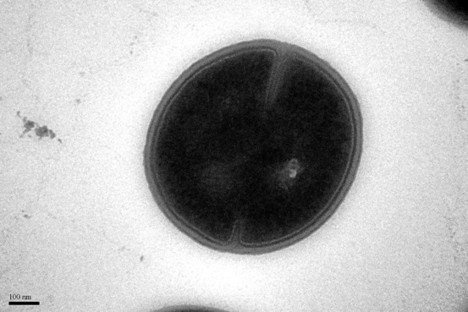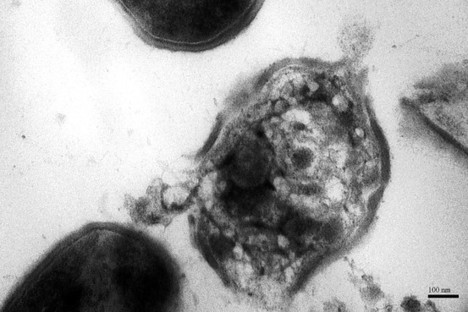 “A MRSA cell before treatment with nanoparticles.” Source of caption and photo: online version of the WSJ article quoted and cited below.
“A MRSA cell before treatment with nanoparticles.” Source of caption and photo: online version of the WSJ article quoted and cited below.
(p. A3) Researchers at International Business Machines Corp. said they developed a tiny drug, called a nanoparticle, that in test-tube experiments showed promise as a weapon against dangerous superbugs that have become resistant to antibiotics.
The company’s researchers, in collaboration with scientists at the Institute of Bioengineering and Nanotechnology, Singapore, said their nanoparticle can target and destroy antibiotic-resistant bacteria–such as the potentially lethal Methicillin-resistant Staphylococcus aureus, or MRSA–without affecting healthy cells.
. . .
IBM, based in Armonk, N.Y., has been working for decades on nanotechnology, which involves engineering atomic-scale particles and electronics. Recently the company has applied those principles–used to create tiny, fast semiconductors–into new areas such as water purification and recyclable plastics. It’s now applying those principles to medicine.
“It turns out that we’ve discovered a lot of ways to control materials at the molecular level as we went through building microelectronic devices,” Dr. Hedrick said.
For the full story, see:
RON WINSLOW And SHARA TIBKEN. “Big Blue’s Tiny Bug Zapper; IBM Researchers Develop Nanoparticle to Destroy Antibiotic-Resistent Bacteria.” The Wall Street Journal (Mon., APRIL 4, 2011): A3.
(Note: ellipsis added.)
 “What’s left of the cell after getting zapped.” Source of caption and photo: online version of the WSJ article quoted and cited above.
“What’s left of the cell after getting zapped.” Source of caption and photo: online version of the WSJ article quoted and cited above.

